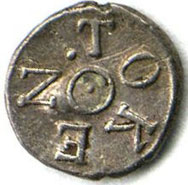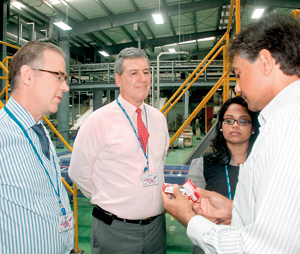Ruwanwella: Colourful history of battles and diplomacy
View(s):The crumbling remains of two forts (one Dutch, one British), an old barn once used to store arecanuts and some rare silver tokens bearing the legend Fanam are all that remain to tell the tale. They are all connected to Ruwanwella – one of the key points along the ancient road that once stretched all the way from Kotte to Kanda Uda Rata.

Frederick Medis
The road, trodden on by native kings and colonial generals alike, brought the two forces together in furious battle more than once, but it was also the path of diplomacy and trade.
A team led by Elmo Alles from the National Trust of Sri Lanka have long since adopted the road – championing the preservation of the many sites of archaeological and cultural interest along the route as well as well as gathering and disseminating new research relating to it. The Sunday Times carried their story (http://sundaytimes.lk/110904/Plus/plus_01.html) when they first began.
This time around speakers at the National Trust seminar held at Palangomuwa Gabadawa, Ruwanwella. included Srilal Perera talking on Oxen pack Thawalam transport, K. D. Paranavithana on the treaties between the Dutch and the Kandyan Kings, Prof. John Balachandran on the ancient engineering feats of Sri Lankans, Mike Anthonisz on the Dutch Governors of Galle and Colombo, Waruna Ranasingha on the Devale ritual of the deified Rajasinha 1st, Prof. Gamini Adikari on the their proto-historic excavation site close to Palangomuwa, Ashley De Vos on the ancient route from North East to the North West of Pihiti Rata and Gunadasa Kumarasiri on the Ambalama at Ruwanwella.
Together, they have taken the project into its second phase at Ruwanwella. A penultimate phase is scheduled to be held in the ancient city of Menickadawara where a series of discussions are planned. The final phase, which will unfold in Balana, still lies ahead.
Frederick Medis, the President of the Royal Commonwealth Society in Sri Lanka and one time president of both the Sri Lankan Numismatic and Philatelic societies, was one of the first to address the gathering. His story, beginning in early March of 1800, placed the British General Hay McDowall in Ruwanwella on his way to an embassy with the King of Kandy. McDowall’s men had already encountered what the Dutch had dubbed the ‘worst enemies’ they had on the island – its leeches. “The men were infested in this march by leeches to a most alarming degree, and most of them had their legs and different parts of their bodies streaming with blood,” Mr. Medis says. Bloodthirsty parasites were, however, just one of the many obstacles McDowall and the 19th Regiment had to face as they braved the old Colombo-Kandy road.

Fanam coin
Four battalion companies, supplemented with native troops set out from Colombo with the intention of making their way to Kandy via Sithawaka and Ruwanwella. So far, they had found the going very hard indeed. “Finally the path taken by McDowall’s troops became so bad that the artillery had to be left five miles in the rear with an escort of sepoys whilst the 19th Regiment and the rest of the native troops marched to the King’s Royal Gardens near ‘Ruanelle’ where they encamped,” says Mr. Medis. In total, the trip would take them many days and toward the end General McDowall would be forced to leave his heavy guns behind and press on to Kandy with a smaller complement of officers. He and his party would return to Colombo only on the 14th of May, having expended a month of their lives on an agonising journey that today would have taken him a matter of hours.
The embassy to Kandy has since been immortalised in history but at that time, the group’s determined members shed sweat, blood and tears to make what was essentially a courtesy call. “The object of the mission was to keep up friendly intercourse with the kings as well as with a view to political objects of importance,” says Mr. Medis. With so many ambitious men about, the peace was a fragile thing. Just two years later, the British would march down the same route, this time intent on claiming recompense from the Kandyan King for goods (primarily a large stock of arecanut and 602 cattle) that had been confiscated from their Moorish trading partners. They were accused of being spies for the British, who at that point governed the low country maritime provinces. The Adigar Pilimatalauwe, himself suspected of having designs on the throne, was believed to be behind the move. Repeated demands for compensation from the local British government were ignored by the Kandyan court.
At the head of a small army, the first British governor of Ceylon, Frederick North would take the road through Ruwanwella to Kandy, determined to claim his recompense by force. Though he would be handily rebuffed, Mr. Medis believes the campaign marked the beginning of the war that would dethrone the King in the hills. “The thrust of my argument is that Ruwanwella was at the central whorl of the calamity which triggered the war with Kandy,” says Mr. Medis, offering his version of the build up to the decisive battle that would take place over a decade later.
Though Thomas Maitland would take over from Governor North, the glory of conquering the Kandyan kingdom that had survived over 2,000 years would go to another man – Robert Brownrigg. The Kandyan court had already begun to fracture from within, when in 1814, 10 villagers who were found trading in the British controlled area near Colombo became the catalysts for war. They were sent back to the Colombo city by the King of Kandy with their right hands, right ears and noses cut and tied around their necks. Having left a trail of blood behind them, seven died en route. It was all the excuse Governor Brownrigg needed to declare war. Amongst chieftains from Sabaragamuwa, a proclamation was made at Ruwanwella on February 10, 1815 in which they committed to ousting the King of Kandy but promised that the Buddhist religion would be held sacred.
Though determined to bolster the defences by repairing and even constructing fresh fortifications at Ruwanwella and elsewhere, Governor Brownrigg found himself short of ready money. “To obtain permission from Britain, for the minting of coins for this purpose – especially for the payment of labour and the defence of the establishment would take weeks, sometimes months,” explains Mr. Medis, adding that this led Governor Brownrigg to take the audacious step of minting his own money, unsanctioned by the powers that be. His token silver piece or Fanam was worth 1/12th of a Ceylon Rix-Dollar and amounted to the daily wage of a labourer.
“Ruwanwella fort and many other defences were probably funded and paid for by the Fanam tokens which are now rare numismatic items,” says Mr. Medis. Having successfully brazened it out, Governor Brownrigg would have an eventful stay in Ceylon – riding out the unrest of 1818 as well before returning home in 1820 with his wife. Today, his initials can still be seen over the entrance arch of the fort at Ruwanwella. Having played such a pivotal role in history, the fort at Ruwanwella has now become the home for the local police station. However, for history buffs a visit to the site has its rewards – especially if they take along someone who knows its colourful history, says Mr. Medis.
The fall of a flag and a Kingdom lost
Is this the flag King Sri Wickrema Rajasingha the last king of Kandy carried into battle? “The original of this flag was located at the Chelsea Military Hospital, London by the late E.W. Perera,” says historian and archaeologist Srilal Perera, explaining that records reveal that king Sri Wickrema Rajasingha carried this battle flag as he led the Sinhala army to fight against the British at Hanwella Fort in the September of 1803.
The story goes that when the flag bearer was struck down, he dropped the flag, causing panic in the King who fled the battle field. The Kandyan forces were subsequently routed and forced to retreat to Ruwanwella.
The flag is dense with symbols representing the arsenal of the gods: in the centre is the Davunde drum, traditionally seen in the right hand of Lord Nataraj. The simple circlet is the chakra audhaya, the lethal disc normally seen spinning on the finger of Lord Vishnu. The kaduwa or sword, belongs in the hand of Skanda, the god of war.
The yudha porawa or battle axe belongs to Lord Ganesh. The keti dunna, a short bow, is associated with the twelve handed god Katharagama and finally the illuk-kolayudhaya whose double sphere at one end allows it to bend and twist when thrown at an enemy.
comments powered by Disqus





















